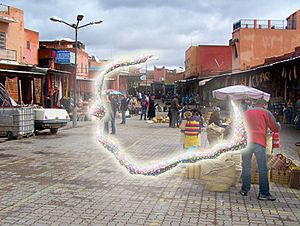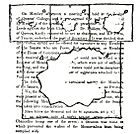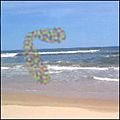Aura (symptom) facts for kids
An aura is a special feeling or sensation some people have right before a migraine headache or an epileptic seizure. It can involve things you see, hear, smell, taste, or feel. The word "aura" comes from a Greek word meaning "breeze." These feelings happen because of how the brain works, making it a neurological event.
Contents
Migraine Auras
Not all migraines are the same. About 15% of people who get migraines also experience an aura first. These auras can cause different symptoms. You might have problems with your vision, like not being able to see clearly for a short time. Some people see zig-zag lines or floating spots. Other symptoms can include dizziness, a ringing sound in the ears (called tinnitus), or trouble speaking. It can take up to an hour after the aura starts before the migraine headache begins.
Epileptic Seizure Auras
Many people with epilepsy have an aura before they have a seizure. This can be very helpful. The aura acts as a warning sign, letting the person know that a seizure is coming soon. This gives them time to find a safe place to sit or lie down. The time between the aura and the seizure is usually short, often just a few seconds or minutes.
Other Causes of Aura-like Symptoms
Sometimes, other brain conditions can cause feelings that are similar to an aura. For example, a stroke or a panic attack might cause symptoms that feel like an aura.
Common Aura Symptoms

Auras can cause many different feelings and changes. Here are some common ones:
- Difficulty speaking: You might find it hard to say words clearly.
- Vertigo: This is a type of dizziness. It feels like you or everything around you is spinning. You might also feel off balance.
- Scotomas: These are "blind spots" in your vision. You might not see anything in a certain area.
- Scintillating scotomas: Also called teichopsia, this is when you see bright, wavy lines or a spot with flickering lights. This spot often grows into shimmering arcs or curves of white or colored lights.
- Fortification: This means seeing zig-zag lines. They can look like the walls of an old fort.
- Changes in vision: Your eyesight might become blurry or distorted.
- Photopsia: You might see sudden flashes of light.
- Tinnitus: This is a ringing or buzzing sound in your ears.
- Muscle weakness: Your muscles might feel weak, often on one side of your body.
- Bilateral facial pain: You might feel pain on both the left and right sides of your face.
- Tingling feelings: You might feel pins and needles, like when your foot falls asleep.
- Numbness: After tingling, you might lose feeling in a part of your body. This often happens on one side, like in an arm, leg, or part of the face.
- Alice in Wonderland Syndrome: This is a type of hallucination. It makes things or people look much smaller (micropsia) or much bigger (macropsia) than they really are.
Scotomas Explained
A scotoma comes from the Greek word for darkness. It is a "blind spot" or an area where your vision is reduced. This spot is surrounded by areas where you can see normally. Scotomas can affect one or both eyes. They can be absolute, meaning you see nothing at all in that spot. Or they can be relative, meaning you can see something, but it's much less clear than usual.
- Negative scotoma: This is an area where you have partial or total blindness. It might feel like a blank spot where you can't see any light. Or it might be blurry, like looking through thick plastic. People often don't notice negative scotomas themselves. They are usually found during an eye exam.
- Positive scotoma: This is an area of vision loss that you can actually see. It might look like a dark or black spot. Or it could be shapes or lines that change in brightness, making them seem to flicker.
Types of Scotomas:
- Fortification scotoma: You see lines that look like the walls of a fort. These lines can be gray or colored. Their brightness might change, making them appear to flicker. When they flicker, they are often called a scintillating scotoma.
- Scintillating scotoma: This is what a fortification scotoma becomes when the lines start flickering quickly. It's one of the most common scotomas seen by people with migraine auras. It usually starts as a small spot of flickering lights in the middle of your vision. Then, it gets larger and spreads out.
Images for kids
-
Flickering animation of a scintillating scotoma, where the scintillations were of a zigzag pattern starting in the center of vision, surrounded by a somewhat larger scotoma area with distortion of shapes but otherwise melting into the background similarly to the physiological blind spot.
See also
 In Spanish: Aura (síntoma) para niños
In Spanish: Aura (síntoma) para niños










